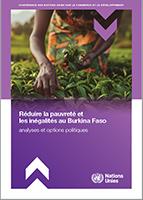
Since Burkina Faso gained independence in 1960, successive governments have sought to promote economic growth in order to reduce poverty and inequality. Despite the adoption of a number of economic and social policies, Burkina Faso remains one of the Least Developed Countries (LDCs), with a large proportion of its population still living in poverty and inequality. In 2021, real GDP per capita was USD 740 per year, compared with an average of USD 1,053 for LDCs. Nearly four out of ten people live in extreme poverty, and according to the UNDP 2021-2022 human development report, Burkina Faso was ranked 184th out of 191 countries worldwide.
These results can be attributed, among other things, to the structural problems of its economy, manifested by (1) insufficient production capacity for goods and services, (2) the difficult transition from a highly centralised state economy to a market economy, (3) major political instability, (4) the geographical handicap of being landlocked, (5) external debt, (6) demographic factors, (7) shortcomings in the quality of institutions and governance, and (8) socio-cultural constraints.
The purpose of this report is to take a brief look at the economic and social policies implemented by the governments of Burkina Faso to reduce poverty and inequality from the 1990s to the present day. The report first analyses the results of these policies before the advent of the health pandemic, as COVID-19 drastically reversed the progress made. A section is devoted to the impact of the pandemic on economic growth, poverty and inequality.
Several economic and social development plans and programmes aimed at reducing poverty and inequality in Burkina Faso have been partially or fully implemented. One example is the National Economic and Social Development Plan (2016-2020), a flagship national reference document. Various reports have given a mixed assessment of these socio-economic policies, but have welcomed some of the progress made.
Burkina Faso's economy, whose main exports are gold, cotton and oilseeds, is poorly industrialised and transformed. The persistence of poverty in a context of economic growth reflects an economy that creates few decent jobs. In fact, this growth is driven by sectors that are not very labour-intensive and in which the local population plays little part in the production process. Gold, for example, is the country's main export, and is sold unprocessed, reducing its potential for industrial development and job creation. To address this challenge, there is the need to improve productive capacities and diversify exports to boost employment and reduce poverty.


